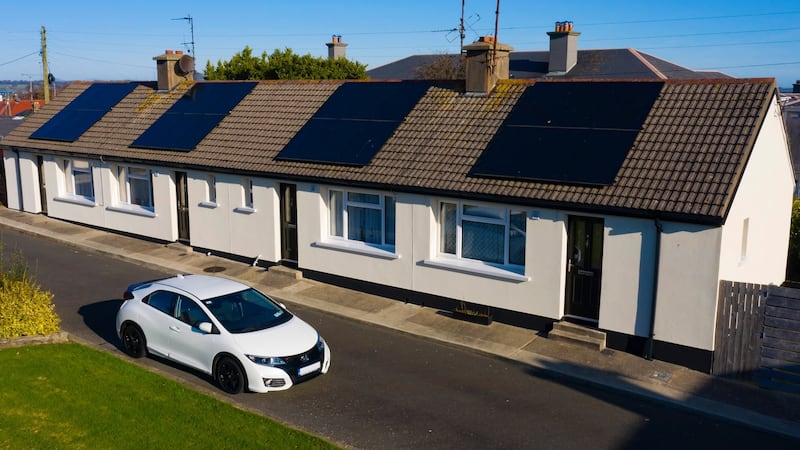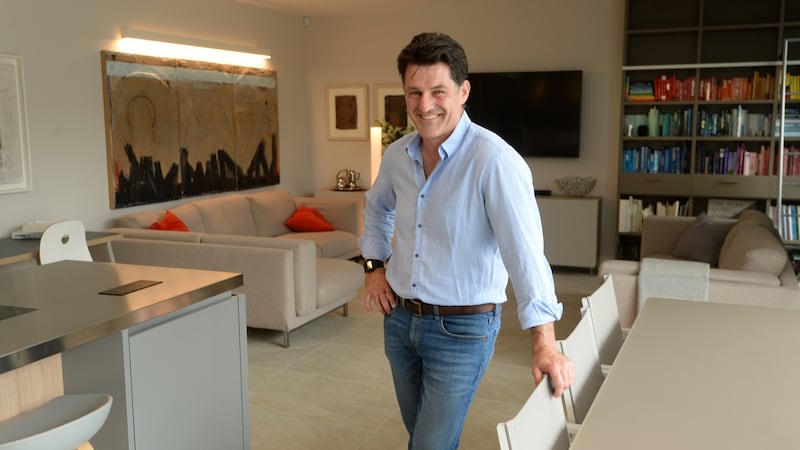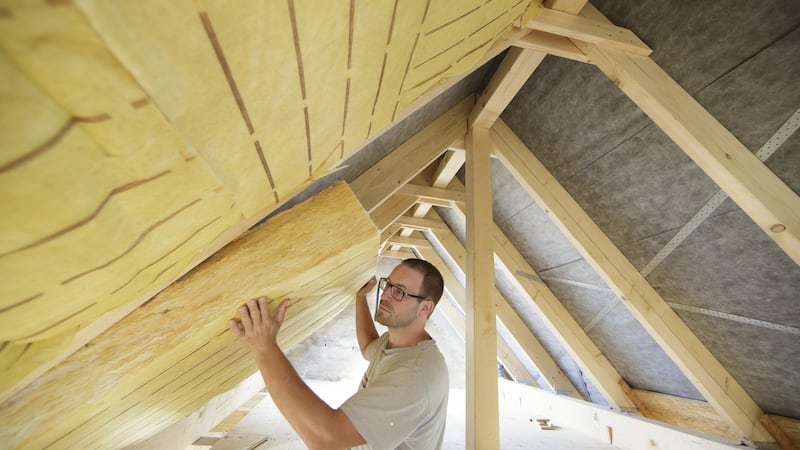What’s in it for me? This is a nakedly self-serving but entirely understandable question that has probably been in the minds of many people as they have tried to get their heads around what the Government claimed this week was the most ambitious home retrofitting plan in the world.
If the script is followed – and given successive governments’ miserable track record when it comes to delivering massive infrastructural developments, it has to be if rather than when – the retrofitting programme will make at least half a million Irish homes warmer, more environmentally friendly and cheaper to run over the next eight years or so.
But the scale of the task is monumental. The programme, which will be the largest infrastructure investment this decade, will see €8 billion invested by the State and a similar amount spent by homeowners and more cash again pumped into the enterprise by the construction sector.
The total spend is likely to top €20 billion, and for the Government to reach its goal of half a million homes it will need to see 50,000-70,000 houses done each year between now and 2030.
Last year just over 11,000 houses were retrofitted.
Despite the scale of the mountain to be climbed there is little margin for error or delay and the plan will require a huge amount of labour and significant buy-in from homeowners who will have to lay down thousands of euro of their own to make their homes warmer and less toxic for the world around them.
'It is being sold with talk of the impact it will have on bills, but it should be sold in terms of carbon emissions and comfort of your house'
Dr Shane Colclough is a UCD-based academic working out of the school of architecture, planning and environmental policy and vice-chairman of the Passive House Association of Ireland. He is also the founding co-chairman of Nearly Zero Energy Building (NZEB) Ireland.
He has seen up close the benefits of retrofitting and believes that not only can it make life much better, much cheaper and much less damaging to the planet, it can even be a matter of life and death.

When asked how people might benefit from retrofitting their homes, he turns to research he undertook three years ago on a cluster of 12 small council houses in Co Wexford.
“They had a BER rating of F and G when Wexford County Council set about upgrading them to an A rating,” he says.
The houses were fitted with PV (photovoltaic) solar panels and enhanced ventilation, as well as wall and attic insulation and a heat pump at a cost of €25,000 per house, minus a grant of €12,000.
“It absolutely transformed the lives of the people living in those houses,” says Colclough. “Many of the people living there were older and they were vulnerable and they spoke of how cold their homes were and how they would have to routinely and regularly clean black mould off their walls.”
After the retrofitting, everything changed. A man in one house saw the average temperature of his home during the winter months climb from less than 20 degrees to 24.5 degrees.
But that wasn’t all.

“Before the retrofitting the people in those houses were spending an average of €1,415 each year to heat them and after the retrofitting the average fell to €380. That is a big saving,” he says. “They were saving 74 per cent in terms of their annual running costs and they were in this house with an average temperature of 24.5 degrees.”
While annual savings of €1,000 are substantial, it would still take a full 13 years for someone to claw back the cost of the project, not including the €12,000 grant from the Sustainable Energy Authority of Ireland (SEAI).
For those who are looking for a greater return than a simple reduction in their bills, Colclough has good news. “Here’s the real rub,” he says, still talking about the Wexford project. “We got a valuer in after the retrofitting had been done. She told us that while the houses were in a great location, they were old and damp. Now they had gone from an F and G rating to an A rating, she estimated that the value of each had gone up by €35,000.”
Architect Mel Reynolds highlights a likely skills shortage and bemoans the fact that the government did not start the process of upgrading their own stock three years ago
There is also research carried out on behalf of the ESRI that suggests that for every point up the 15-point BER scale a house climbs, 1 per cent is added to the value.
Colclough has an even more dramatic illustration of the benefits. “One of the older residents fell out of bed and was lying on a bedroom floor from 2am until found by a neighbour the following day. The paramedic said that if the house had not been done, they could have died, because you can imagine an F- and G-rated home, they would have been freezing.”
Although retrofitting is not likely to be such a stark matter of life and death for most people, it is, he says, a “no-brainer”.
Mel Reynolds is an architect who works at making homes passive – other people’s and his own. “I think we have to do this; 40 per cent of homes in Ireland have oil-fired central heating, so in terms of climate change we have to do it,” he says.
He highlights a likely skills shortage and bemoans the fact that the government did not start the process of upgrading their own stock three years ago. “There are 140,000 houses owned by local authorities that have really poor energy ratings because they are older stock and they are all in the control of the State, and if we had started on them earlier then we would have been more prepared to hit the ground running today.”

He adds that the project is being pushed in terms of financial gain, but questions whether that is the approach to take. “It is being sold with talk of the impact it will have on bills, but it should be sold in terms of carbon emissions and comfort of your house,” he says.
“If you have just bought an old house and are doing work on it, then this is a no-brainer,” says Reynolds. “But it is different for houses owned by people who would like to do it but who may not have the money.”
Affordability is going to be one of the biggest stumbling blocks for the project. It is all well and good to say the State will pay half the costs of a retrofit, but that does not answer how someone already struggling financially can find the other half. One unanswered question is the availability of low-cost loans; more information on that is promised later this year.
If a retrofit costs €50,000, and the grant is €23,500, a 10-year loan to cover the rest would cost about €253 per month on a 3 per cent interest rate based on examples provided by the Department of the Environment.
Once anticipated monthly energy savings of €83 are subtracted, the loan would cost about €170 a month to repay over 10 years, or €50 per month over 20 years, at a lower interest rate of 2 per cent.
Another key question – for many people the only question that will matter – is, how much will it cost and how much will I save?
'We need to help people to understand that it is not simply a case of putting in money so you can get a return'
Reynolds highlights the financial returns, or perhaps the lack of them. “The payback has always been the Achilles heel of schemes like this, but the difficulty now is we just have to do it,” he says before addressing the actual financial benefits.
“The payback period for attic insulation is about eight years,” he says. “You might make annual savings on your heating of €500, which, looking at it coldly, is not an awful lot but your house will be a lot more comfortable to live in and there are the added environmental benefits too. And you do get an uplift on your valuation – for every €1 you spend you add €2 to your property value.”
“We need to help people to understand that it is not simply a case of putting in money so you can get a return,” says SEAI spokesman Tony Halpin. “You are putting in that money to make your life more comfortable and add to the value of your home. It is a transformative step. People look for return on investing of energy but not on the installation of a marble countertop or a wet room.”

There is also an issue of complexity. Many people will be scratching their heads and wondering where to start or how to ensure they are not ripped off in what is likely to be a seller’s market.
Reynolds hails the idea of the one-stop shops, which is central to the project. These should, he says, smooth the process for many people. The SEAI website will carry details of companies that will effectively perform the function of a lead contractor on a house renovation.
'There are obvious health benefits to living in a warm, better-insulated home and that has a knock-on benefit when it comes to healthcare costs for the Government'
The one-stop shops will conduct a home energy assessment at your expense and provide a quote as well as talking you through the grant process. If you give them the go-ahead, they will handle the grant application and engage the subcontractors to do the work, with the grant being deducted from your final bill.
It can be done in one fell swoop or over time. Reynolds says the least expensive first step will be roof insulation, followed by walls, windows and heating. Floors that need to be dug up and relaid are the most cumbersome and costly element of a deep retrofit.
“The good thing about this way of doing it is shouldn’t be all or nothing, it should be a case of ‘What can I do?’ You start with your plan and you end up with a menu of options. If you have a BER rating of F or G, you do your roof first and then the external insulation and then the window and so on. Think of it like being in a restaurant and being handed a menu. You can have the starter, the main course and dessert, or just a starter.”
Colclough is keen to stress that some of the benefits are less tangible than others. “There are obvious health benefits to living in a warm, better-insulated home and that has a knock-on benefit when it comes to healthcare costs for the Government. And if people aren’t spending €1,200 on heating they will spend it in the local community, and then of course there is the employment generated by the project.”
He adds that there will be a question mark over many properties where the beneficiaries of the dramatically improved living conditions will not be those paying them.
“Take that Wexford example. The council paid for the retrofitting but only saw a benefit in reduced maintenance and call-out charges, but government is seeing all the indirect benefits, including reduced carbon emissions and reduced healthcare costs, while the individual is getting massive benefits. So we need to think more about the decision-makers and how to incentivise them. Retrofitting is the right thing to do but how do you convince the decision makers it is the right thing to do?”

He also accepts that, for many people, the improvements will not be as dramatic as the Wexford example he leans on.
“Someone sitting in a house built 15 or 20 years ago will have to ask if it makes sense, as they won’t be seeing black mould disappearing from the walls or anything as dramatic as that.”
'Retrofitting will make your bills a lot more manageable, but that is just the short-term view. Ultimately it's your children and your children's children who will benefit'
For someone living in a relatively modern four-bedroom house and paying about €3,000 in energy costs each year, he envisages they will make some savings, but it would take a long time before they would make back the €40,000 they would spend on a retrofit that might cost a total of €65,000. “It is a clear-cut case if you are going from a terrible house to a great house, from an F- and G-rated house to an A-rated one. But if you are in a house that has a C rating and you retrofit, then you might see a reduced energy bill of €1,000 a year.”
The impact on bills is not the be-all and end-all, says Noel Larkin, a chartered building surveyor. “Retrofitting will make your bills a lot more manageable if you get a rating up to B2, but that is just the short-term view. Ultimately it’s your children and your children’s children who will benefit,” he says. “And when you are investing in the next generation, things are never as straightforward.”
He says that people can approach it in different ways. They can do the whole thing in one go or, “if they want to bite this off in small chunks, they can, and then they will have to decide what is the biggest bang for their buck”.
And what is that? Insulating your attic – or reinsulating it, if has been done previously, will see 25 per cent less heat leave your home, while addressing the windows also provides quick return.

He says that for many people the very thought of “someone coming in to dryline walls and pulling the place asunder is too much, but there are ways to do at least some of it externally, but you have to be certain the job is done right. The challenge is to make sure the work is done to a certain standard, so the one-stop shop will be important. There is scope for another layer of oversight, and I suppose people would say, as a building surveyor, ‘You would say that’.”
Larkin adds that the labour force that is required to do all this work “is not there currently and there is competing demand between building houses and doing this. Every industry in the country is struggling in terms of the supply of workers, and this is no different. The reality is that 70,000 houses is a lot of work, and it is skilled work, and currently the labour isn’t there.”
He points out that 90,000 houses were built in one year in the boom, “which is an enormous amount of work, but there was a huge amount of labour brought in from overseas, and we could do that again, if they will come and if we can find them somewhere to live – and none of that is easy.”
AT A GLANCE: WHAT YOU NEED TO KNOW
– Residential emissions account for about 11 per cent of Ireland’s total greenhouse gas emissions and generate about seven million tonnes of carbon dioxide every year.
– Irish buildings are 70 per cent reliant on fossil fuels, and the majority of housing stock is energy inefficient, with more than 80 per cent carrying an energy performance rating of C or lower.
– Irish homes use 7 per cent more energy than the EU average and pump out 60 per cent more carbon dioxide.
– About 1.5 million homes will need retrofitting.

– Approved “one-stop shops” will conduct a home energy assessment at your expense and provide a quote for the work. If engaged, they will handle the grant application and hire the subcontractors to do the work, with the grant being deducted from your final bill.
– According to official estimates, a deep retrofit will cost a maximum of €66,000, which means the State will stump up about €25,000 for those who choose to get it done.
– Rather than doing it all in one go, there will be an option to approach it in a piecemeal fashion. The grants will stay the same, but fewer upgrades are covered.
– There will also be an enhanced grant to cover 80 per cent of the typical cost for attic and cavity-wall insulation, which will be operated through the Better Energy Homes Scheme, and up to 20,000 homes are expected to benefit.


















